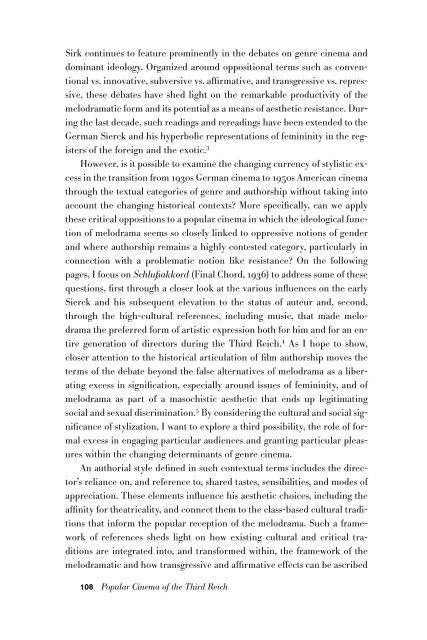Create successful ePaper yourself
Turn your PDF publications into a flip-book with our unique Google optimized e-Paper software.
Sirk continues to feature prominently in the debates on genre cinema and<br />
dominant ideology. Organized around oppositional terms such as conventional<br />
vs. innovative, subversive vs. affirmative, and transgressive vs. repressive,<br />
these debates have shed light on the remarkable productivity of the<br />
melodramatic form and its potential as a means of aesthetic resistance. During<br />
the last decade, such readings and rereadings have been extended to the<br />
German Sierck and his hyperbolic representations of femininity in the registers<br />
of the foreign and the exotic. 3<br />
However, is it possible to examine the changing currency of stylistic excess<br />
in the transition from 1930s German cinema to 1950s American cinema<br />
through the textual categories of genre and authorship without taking into<br />
account the changing historical contexts? More specifically, can we apply<br />
these critical oppositions to a popular cinema in which the ideological function<br />
of melodrama seems so closely linked to oppressive notions of gender<br />
and where authorship remains a highly contested category, particularly in<br />
connection with a problematic notion like resistance? On the following<br />
pages, I focus on Schlußakkord (Final Chord, 1936) to address some of these<br />
questions, first through a closer look at the various influences on the early<br />
Sierck and his subsequent elevation to the status of auteur and, second,<br />
through the high-cultural references, including music, that made melodrama<br />
the preferred form of artistic expression both for him and for an entire<br />
generation of directors during the Third Reich. 4 As I hope to show,<br />
closer attention to the historical articulation of film authorship moves the<br />
terms of the debate beyond the false alternatives of melodrama as a liberating<br />
excess in signification, especially around issues of femininity, and of<br />
melodrama as part of a masochistic aesthetic that ends up legitimating<br />
social and sexual discrimination. 5 By considering the cultural and social significance<br />
of stylization, I want to explore a third possibility, the role of formal<br />
excess in engaging particular audiences and granting particular pleasures<br />
within the changing determinants of genre cinema.<br />
An authorial style defined in such contextual terms includes the director’s<br />
reliance on, and reference to, shared tastes, sensibilities, and modes of<br />
appreciation. These elements influence his aesthetic choices, including the<br />
affinity for theatricality, and connect them to the class-based cultural traditions<br />
that inform the popular reception of the melodrama. Such a framework<br />
of references sheds light on how existing cultural and critical traditions<br />
are integrated into, and transformed within, the framework of the<br />
melodramatic and how transgressive and affirmative effects can be ascribed<br />
108 Popular Cinema of the Third Reich

















